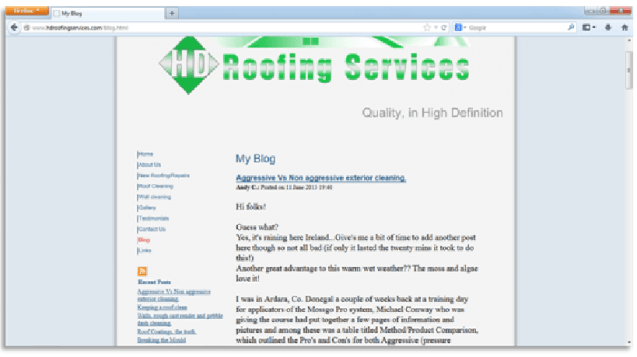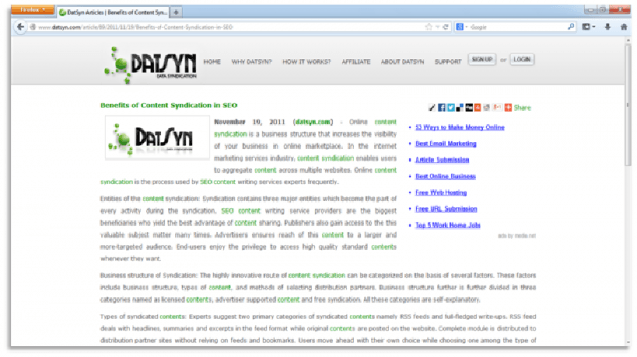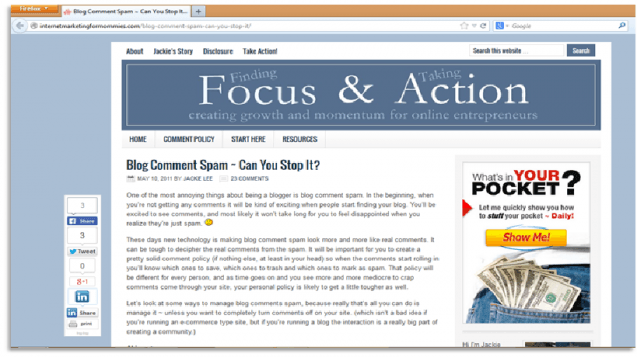Since exploding onto the scene a few years back, the term ‘blogging’ has grown to encompass much more than just keeping an online ‘journal’ for your friends to read. These days most websites have a blog of some sort – and often that will be what makes up the main bulk of the site.
That’s why every self-respecting website needs a blog, and it’s why anyone with an online presence will keep one: from journalists to hobbyists and especially businesses. Having a company blog is one of the very best ways to attract customers to a company’s website, it’s great for marketing and SEO, and it’s even better for building customer loyalty.
But blogging is also a nuanced and delicate process with a steep learning curve- it takes some work to get right. If you don’t know how to make the most out of a company blog, then at best you’ll be wasting your time and far from helping you with all those things it can actually risk damaging your organisation.
This is a common problem for a lot of CEOs and entrepreneurs that have little experience in running a website or writing content, but nevertheless dive in at the deep end and start posting.
To make sure that this doesn’t happen to you and that you aren’t wasting your blog, read on and we’ll go over some of the most common mistakes that businesses make when running their company blogs.
Aesthetics
 (Screenshot taken 10/12/2013 of www.hdroofingservices.com)
(Screenshot taken 10/12/2013 of www.hdroofingservices.com)
The first thing a visitor will notice when they land on your blog is the way it looks, so that seems like as good a place as any to begin. Of course you want to make sure that your blog looks professional and attractive so that it reflects well on your business. If your blog looks poorly made, then people will assume that your products are poorly made too or that your services are shoddy and unreliable.
Firstly then – unless you are a seasoned pro, outsource the web design process. Do some research and don’t just settle for ‘ok’ – find a way to give your site a bit of something extra by getting creative with the design and looking around for inspiration.
Branding
Also important is that your blog match the tone and look of your main site. Even if you use a content management system like WordPress, you still need to make sure that the overall appearance is thematically close to the rest of your site so that the transition isn’t jarring and so that your blog strengthens your branding rather than diluting it. Let your logo/banner inform the rest of your site design and think about this when you design your logo in the first place. Worst case scenario it might be time for a little rebranding…
Lack of Indexing
As mentioned, a blog is an incredibly powerful tool for SEO and marketing – mostly because Google likes to see that a site is being regularly updated with new content. The problem is that many business owners don’t give their blogs the time they need: they don’t write unique content for the blog and instead source it from elsewhere or use content already on their site.
Thus they risk being penalised by Google and the way they often choose to get around that is by telling Google’s spiders not to index the blog at all. Of course this is a huge mistake, as it means you’ll be missing out on all the optimisation benefits that you could be getting from the link.
The solution? Write unique content! It may take a little longer, but it’s more than worth it if it means you can use your blog to its full SEO potential. If you don’t want to write content yourself then outsource the process and hire a writer to handle it for you.
Hosting
Another way you might be missing out on potential SEO benefits if you run a company blog is if you keep your blog hosted on WordPress.com or Blogspot. Not only does this look highly unprofessional (and make it harder for visitors to remember your URL), but it also means Google won’t make the connection between your site and your blog. It won’t look like your site is constantly being fed more content… because it isn’t. So just keep your site hosted on your main domain – remember you can install the whole WordPress CMS right on your site in a separate folder and it won’t cost you any extra.
Keyword Stuffing
 (Screenshot taken 10/12/2013 of www.datsyn.com)
(Screenshot taken 10/12/2013 of www.datsyn.com)
On the other hand, some companies will go too far the other way and bend over backwards in order to try and take their blogs to the top of the search engines. This is fine and even advisable, so long as you are doing your SEO right and aren’t still using outdated techniques. Keyword stuffing for instance was once commonplace among company blogs, but is now a sure fire way to get your site penalized by Google. And it’s always driven away visitors. Optimize your site and your content yes, but not at the expense of writing good quality posts that people actually want to read.
So how do you optimize without stuffing? Well one tip is to make sure you use synonyms for your keywords and phrases – write around the topic but avoid directly repeating the same line too much. That’s good writing, and it’s also what Google looks for.
In the opening and closing paragraphs feel free to use your main key phrase as long as it’s natural (these paragraphs are particularly useful indicators for Google), pick smart headings, and use tags like the ‘alt’ tag on images to hide a few more keywords and variations. That’s subtle but powerful on-page SEO.
Where Did I Put That Blog?
These company’s guilty of keyword stuffing and forgetting their end user will often try to avoid their users from seeing their blogs at all. They view their blogs as little SEO engines that should be running behind the scenes and so don’t even link to them on their main site (or they hide the link somewhere in the site map).
Well in this case you’re benefiting from the SEO (though less so because spiders won’t find it so easily), but you’re still squandering the chance to build a relationship with your customers/promote your products and services. Why not kill two birds with one stone and spend just a little longer making your blog actually good and doing it right so that it helps bring more readers to your site and keep them there longer? Better yet, build it into your site such that there is barely a distinction between ‘site’ and ‘blog’.
You can have your news updated on the front page, and other sections accessible from a menu along the top. WordPress is more than capable of building something like that very easily.
It’s a Little Quiet In Here…
 (Screenshot taken 10/12/2013 of www.internetmarketingformommies.com)
(Screenshot taken 10/12/2013 of www.internetmarketingformommies.com)
Another common problem that company blogs have is that they’re completely barren. How often have you seen a blog on a company website that hasn’t been updated for the last ten years? This will once again mean you’re missing out on the potential of your blog to boost your SEO, and again it will also damage your reputation. It’s not very professional to have a completely empty blog on your site, and it can actually put customers off of using your business – they might think you’ve shut down!
Make sure that you put the time in to post on your site and to write new content regularly. Alternatively, write a large batch now and then use your CMS in order to gradually feed new content to your blog at pre-set times. You can even aggregate content from other sites – butif you can’t do any of that, then consider paying a writer to run your blog for you… or just forget the blog altogether. You’re better off with no blog than a completely empty one.
Tumbleweeds
Just as you want your blog to look active in terms of the posts, it’s also important that it looks active in terms of comments. If your site looks like an active hub of discussion then it will make your company look popular, it will attract more readers and it will make whatever you’re selling instantly more desirable. If it’s completely empty then it suggests you don’t understand marketing, or that you only launched your organisation yesterday.
Of course getting people to comment regularly on your blog is easier said than done and you can get thousands of readers sometimes and still have no one comment. You could write a whole article on this topic, but to give you a boost just make sure you invite discussion in the body of your post and that you respond to every comment.
You can even consider mentioning comments in the body of your article (people love a chance at ‘fame’), or offering prizes and other incentives to your commenters. If that doesn’t get the ball rolling, then consider paying someone to make a few comments (or doing it yourself).
No Moderation
 (Screenshot taken 10/12/2013 of www.theberryranch.com)
(Screenshot taken 10/12/2013 of www.theberryranch.com)
Comments are a good thing then and certainly to be encouraged, but not if they’re all promoting Viagra. Not only do the inevitable links that come with spam take people away from your site (and hurt your SEO too), but they once again make you look like you never check the site or don’t understand how to put defenses in place. Set up a good spam-filter to begin with, but make sure you manually moderate the comments too: the occasional piece of junk will get through no matter how good your defenses are.
A good tip generally that all bloggers should consider, is setting your own site to your homepage. This way you can check your site as the first thing you do every day and hopefully that will allow you to respond to comments more quickly, to find and delete spam and to notice the little tweaks that could help make your site more usable and accessible.
Low Quality
We touched on this already, but just to reiterate: your principle concern with any blog should always be to ensure it’s high quality. People like content that is interesting and useful and so does Google and if you dress it up well on top of that then you’ll have a real winner on your hands.
If you’re unsure as to whether you’ve created a great blog or an average one, then the best way to find out is to survey your visitors and get feedback that way, to watch a friend or family member interact with your blog and to use the trick mentioned earlier of making your own blog into your homepage.
If you spend time and money developing your blog, treat it as more than just a second thought and build it into your business model and your marketing strategy, then it can be a seriously powerful asset in promoting your organization.
And that’s really the take-home message for all these points. They all require you to invest a little more time in your blog, whether that’s in the comments section or in the research you do to find topics; from there you can start putting it front-and-center to proudly bring more traffic to your site and business to your organization.





